Who were the Baker Twins? Were they truly among the first uniformed women in the Coast Guard? Did they even serve in the military during World War I? These questions instigated a months-long exploration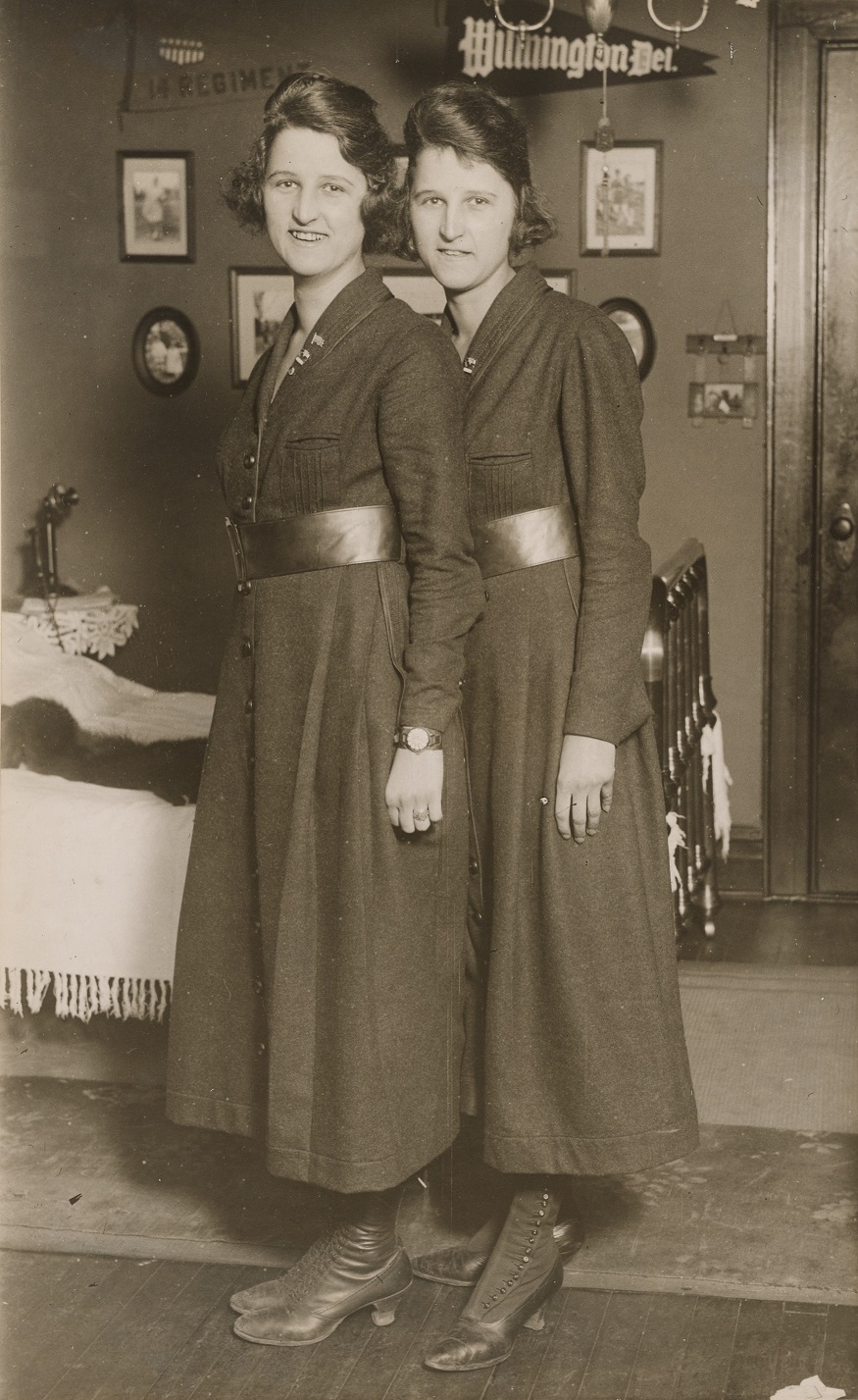 where I scoured archives, interviewed sources, and reviewed crumbling, old personnel records. Painstaking research did yield a definite answer: Genevieve and Lucille Baker did not serve in the Coast Guard or even the Navy during World War I. This article documents the story of how I reached this conclusion.
where I scoured archives, interviewed sources, and reviewed crumbling, old personnel records. Painstaking research did yield a definite answer: Genevieve and Lucille Baker did not serve in the Coast Guard or even the Navy during World War I. This article documents the story of how I reached this conclusion.
Background
Needing more men to fight the war, the Navy recruited women to replace the male clerks, stenographers, typists, telephone operators, translators, and others who went to sea. These women enlisted in the yeoman (F) rating, with the F representing “female” to preclude them from assignment on seagoing vessels. The unofficial but popular term for them is “yeomanette.” According to the myth, the Baker Twins served as Coast Guard “yeomanettes.” Some writers incorrectly assert they were the first uniformed women in the Coast Guard. During World War I, Myrtle Hazard was the only woman to enlist in the Coast Guard and serve in uniform. She had the rating of electrician first class (E1), not a yeoman (F), and she enlisted in January 1918.
Three months later, on or about April 18, 1918, the Baker Twins tried to enlist with the Coast Guard men protecting the Port of New York but were rejected. Nearly 40 years later, in 1957, the myth started when a journal article republished a 1918 press photograph, writing that “The Baker Twins from Brooklyn preferred to serve in the Coast Guard.” Initially, other printed pieces slowly spread the “yeomanettes” myth and their picture. More recently, the internet accelerated the spread using the Instagram-worthy but misleading photograph as “proof” of their service.
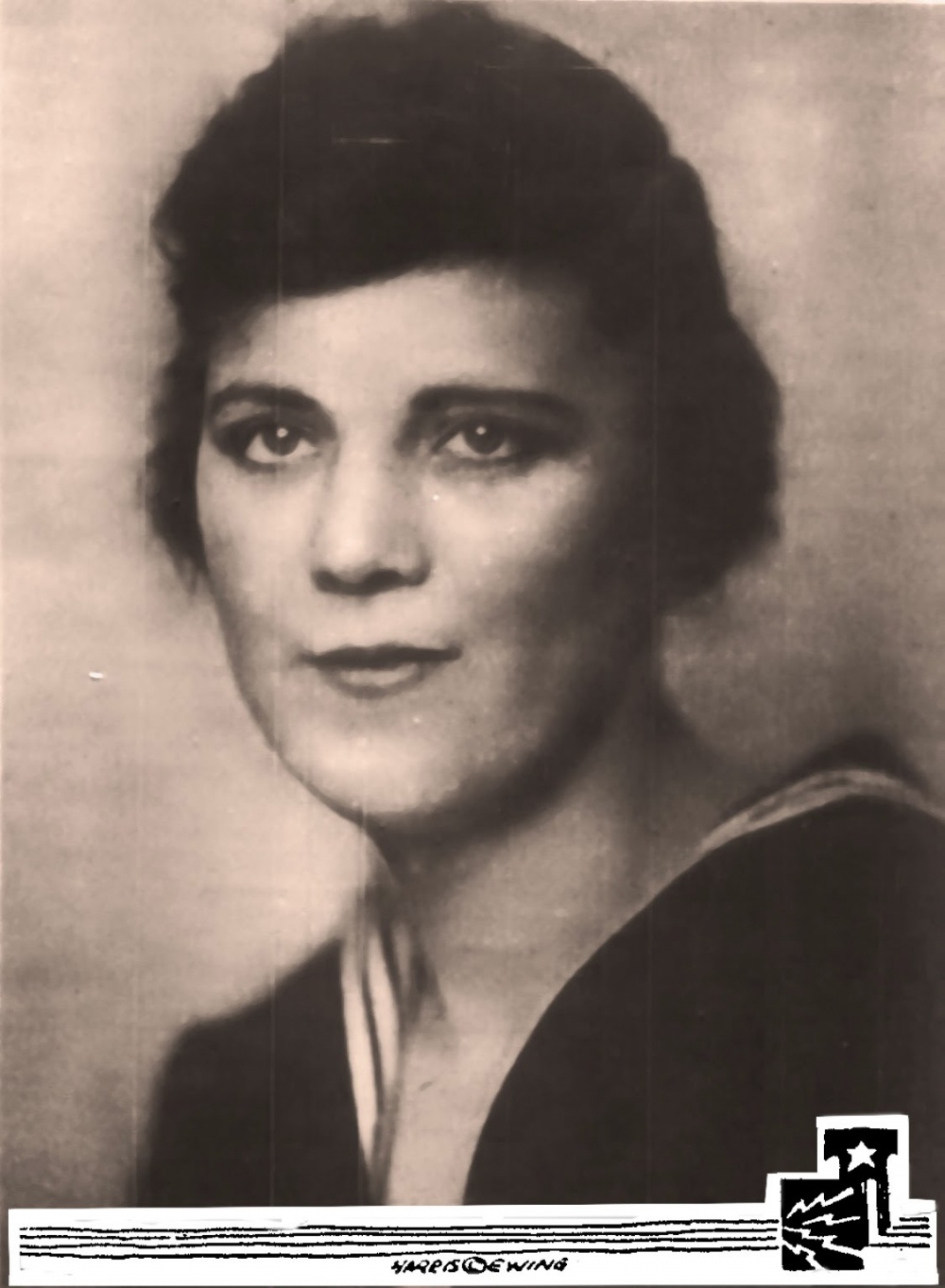 Research
Research
A Coast Guard historian dangled the intriguing suggestion that I research and write about the Coast Guard “yeomanettes” who served during World War I, and I took the bait. He sent me two clues. One listed the names used by Genevieve Baker, and the other was the National Archives response to a request for her records. The response was, “Unable to ID Military record.” The National Archives searched civilian records too. From the civilian side, it responded, “no record could be IDed.”
Ancestry.com
I checked Ancestry.com, finding census records, marriage records, and obituaries. The records there, plus records held by New York City, show the Baker Twins had many names before they attempted to enlist. They were:
1900 Federal Census: Gertrude and Celia Waclaski
1906 Special Certificate and Record of Birth: Genevieve and Cecilia Baker
1910 Federal Census: Genevieve and Cecilia Waclaski
1915 New York State Census: Genevieve and Lucille Waclaski.
1918 Marriage Certificate: Cecilia Waclaski married Edward Steffen nearly one month before she tried to enlist as Lucille Baker.
Ancesty’s link to Genevieve’s obituary revealed the names of her grandchildren. I used those names to find their telephone numbers on Whitepages.com. Before calling them, I searched for stories about the Baker Twins on Newspapers.com.
Newspapers.com
The search on newspapers.com revealed stunning results, exposing how a false narrative about their enlistment was exaggerated, then sensationalized, and finally, unquestioned as truth. News reporters eagerly covered the Baker Twins initial attempts to enlist and reported the rejection. A week later, the International News Service and the International Film Service took the story to a new level by publishing a misleading photograph and false statements. The story morphed from an attempt to enlist to a seeming confirmation of their service.
On April 19, 1918, the Brooklyn Times Union headline read: “Girl Twins Ready to Fight.” According to the reporter, if they weren’t permitted to join, “it won’t be because they didn’t try hard to enlist. They want to ‘do their bit’ like their two brothers, who are fighting in France. A ‘Battalion of Death’ would suit them nicely.”
The Twins introduced themselves to Coast Guard Lt. Lorenzo C. Farwell as 19-year-old Genevieve and Lucille Baker. Lucille claimed she was a bookkeeper, and her sister was a clerk, “but my my,” the reporter wrote, “they didn’t want any clerical work. They wanted to get right into the guard ranks.” Farwell rejected their offer. The Baker Twins “declined to take his word and stuck around until Capt. Carden came.”
Capt. Godfrey Carden “thought a Coast Guard job was a trifle heavy for the twins but promised to let Washington know that they were ready to serve.” The article continued, “[t]hey left the office disappointed.”
The story changed one week later. On April 25, 1918, the International Film Service copyrighted a photograph of the smiling Twins in what appears to be a bedroom, the background that newspapers later cut out before publication. The Twins wore matching dresses adorned with patriotic pins, the kind anybody could buy at a store. Their Allies Pin with a three-star service pendant was marketed to mothers, fathers, and siblings to symbolize the number of family members serving in the war.
Accompanying the photo was the description, “Genevieve and Lucille Baker, twin sisters, of Brooklyn, N.Y., who enlisted as yeoman in the U.S. Coast Guard. The two nineteen-year-old girls were the first of their sex to enlist in this branch of the service. As both were expert bookkeepers they enlisted as yeoman. They had two brothers in the Army in France.”
None of the statements were true. Their birthday was Feb. 28, 1900, so they were 18, not 19. E1 Hazard was the first female to enlist in the Coast Guard. The Baker Twins certainly were not serving as “yeomen” when the photograph and articles were published because Carden rejected their attempt to enlist. Stanley Waclaski, their only brother, was in Brooklyn, not France. During the darkness of wartime, this entertaining, patriotic human-interest story quickly spread across the United States to Canada and France.
On May 8, 1918, The Evening World presented a second, more truthful version of their reason to enlist, attracting readers with the dramatic headline, “DON KHAKI, REPLY OF GIRL VOLUNTEER TO SIGHING SWAINS.” The article stated, “[t]hey said their only brother had been rejected as a soldier because of physical disability and that the honor of the family rested on their being able to do some active work in defense of Uncle Sam.” I found a military record on Ancestry.com verifying that their brother Stanley was discharged in March 1918 due to disability.
The article described their rejection by the Coast Guard, noting that the “genial Captain wired to Washington to see if regulations could be strained to permit the admission of Lucille and Genevieve; but, alas, red tape would not be snipped.” The same news report included the public’s response to earlier press coverage. Admirers of the “Navy Twins” and “Patriotic Twins” had flooded the Coast Guard office with fan mail addressed to the Twins, which was forwarded to them.
The “winsome twins” returned to the Coast Guard office in May, begging Farwell not to forward any more mail. “We have received 145 letters proposing marriage since the papers published the story about us, said pretty Miss Lucille.” Note that she failed to state that she was already married. “And most of the letters were from men of the draft age who ought to be fighting for their country.” Miss Lucille sent a rejection via telegram to one of the men, stating, “From your photo you look big and strong enough to fight. Hope to meet you in France.”
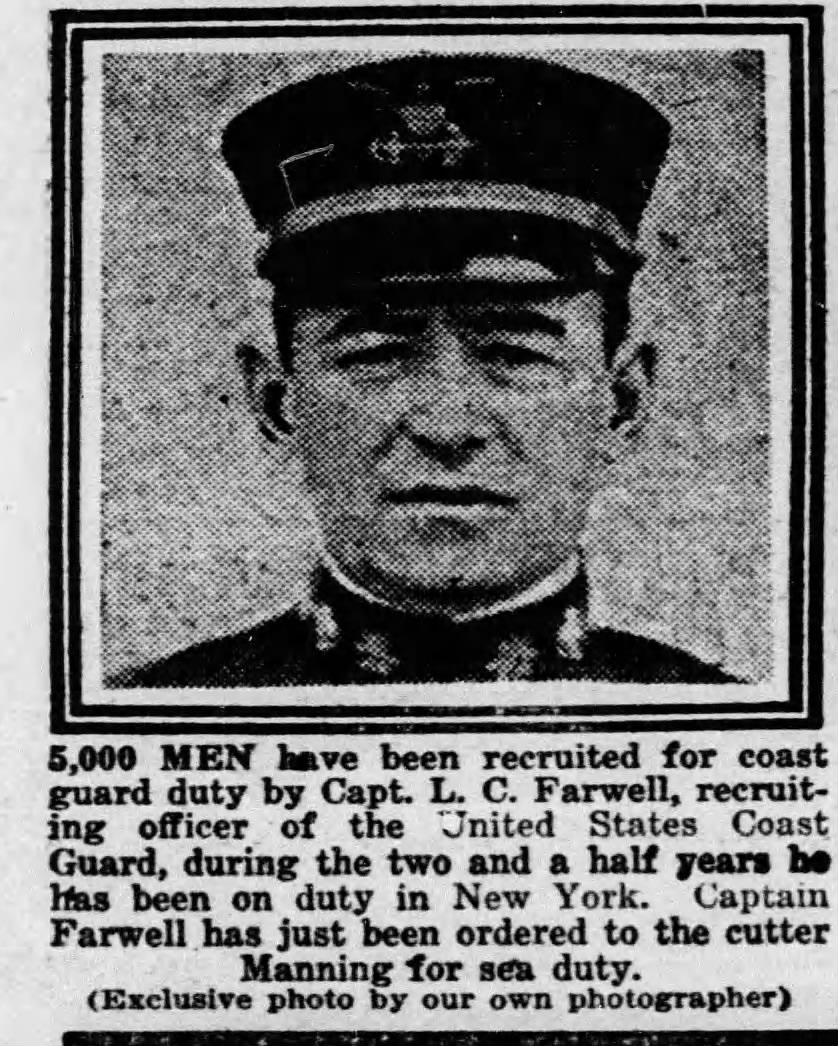 On May 10, 1918, The Brooklyn Daily Eagle reported that, according to their mother, the Twins were offered a yeoman’s rating in the Navy. Since the historian’s clue from National Archives stated, “Unable to ID Military record,” I then decided to call her grandchildren, hoping that they might provide evidence to support the Baker Twins’ story.
On May 10, 1918, The Brooklyn Daily Eagle reported that, according to their mother, the Twins were offered a yeoman’s rating in the Navy. Since the historian’s clue from National Archives stated, “Unable to ID Military record,” I then decided to call her grandchildren, hoping that they might provide evidence to support the Baker Twins’ story.
Phone calls and emails
The family was very gracious, but I was disappointed they had no official documents or artifacts. They told me about the newspaper articles from 1918, more recent magazine articles, and internet postings, but those are secondary sources lacking the reliability of a primary source document.
Via email, the Coast Guard Historian’s office sent me a copy of a journal article from December 1957. Every myth starts somewhere, and the Baker Twins myth originated in that article. In 1918, the Twins’ story disappeared from the news after a few months, but at the time, the International Film Service submitted a copy of the photo and caption to the War Department. Their “twinning” photo lay dormant in a War Department file full of other press photographs. The Army Historical Section eventually transferred that file to the National Archives.
In 1957, the Navy’s chief journalist, O.S. Roloff, submitted the file of long-forgotten unofficial press photographs for publication in the Naval Institute Proceedings journal (Proceedings article). Presented as fact, the caption in Proceedings article states, “The Baker twins from Brooklyn preferred to serve in the Coast Guard.” I decided to track down that file and check the muster rolls.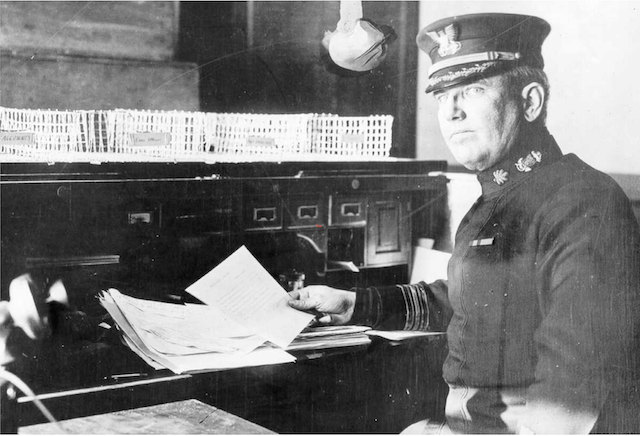
National Archives
The unofficial press photographs file is housed at the National Archives in College Park, Maryland. I compared the descriptions accompanying the original photographs with those used in the 1957 article. The writer created new, sensational descriptions for many of the unofficial press images published from the file without any apparent fact-checking.
I re-read Genevieve’s obituary, which states that she “served with the Yeomanettes at the Brooklyn Navy Yard.” This claim led me to the muster rolls. A muster roll lists naval personnel attached to a naval vessel or station. The National Archives in Washington, D.C., holds the muster rolls of yeomen (F) at the Brooklyn Navy Yard. None of the lists contain any names connected to the twins.
National Archives records also list all the Coast Guard personnel who served during World War I. The only woman on that list is Electrician First Class Myrtle Hazard. A list naming service members from New York does not contain any names connected to the Baker Twins.
U.S. Navy Archives
At the archives the Naval History and Heritage Command holds, I examined yeomen (F) lists that Eunice C. Dessez, former chief yeoman (F) created. The New York list does not contain any names connected to the Twins.
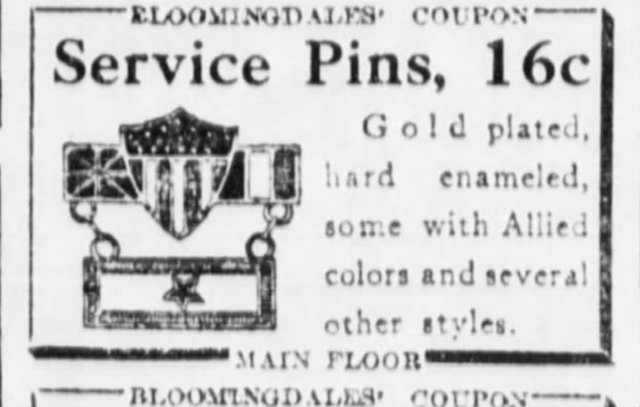 Ancestry.com
Ancestry.com
I returned to Ancestry.com to check the New York, U.S. Abstracts of World War I Military Service, 1917-1919. In 1920, the federal government sent abstracts of World War I military service records for all New York servicemembers, including women, to New York’s Adjutant General. Abstracts exist for Stanley Waclaski and the Baker Twins’ husbands. No records exist for any of the names connected to the Twins.
In 1930, one census question asked if a person was a veteran. I accessed that census on Ancestry.com. The Baker Twins’ husbands and brother were listed as veterans. Hazard was listed as a veteran. The Twins’ boxes are blank, indicating that they did not serve in the military.
Proceedings Article’s Impact
I found no official documentation to verify either the Baker Twins’ military service or the assertion in the Proceedings Article. While the photo and myth resurfaced in the 1980s, they gained steam after inclusion in John A. Tilley’s 1996 article “A History of Women in the Coast Guard.” Some sources accurately state that Hazard was the first to wear a Coast Guard uniform, but others imply that there is a debate about who was first. Some omit any reference to Hazard altogether, attributing honor to the Baker Twins where none was earned.
In sum, the photogenic Baker Twins attempted but failed to join the Coast Guard. Their attempt gathered much publicity, and the Twins’ impassioned effort to enlist and serve is noteworthy. Perhaps the Baker Twins even inspired men and other women to do their bit during the war, though it is impossible to know. A lack of official documentation indicates that Genevieve and Lucille Baker never served in the Coast Guard or the Navy. However, the Baker Twins myth is so widespread, entrenched, and cherished that it could forever overshadow the true story of the first uniformed women in the Coast Guard.